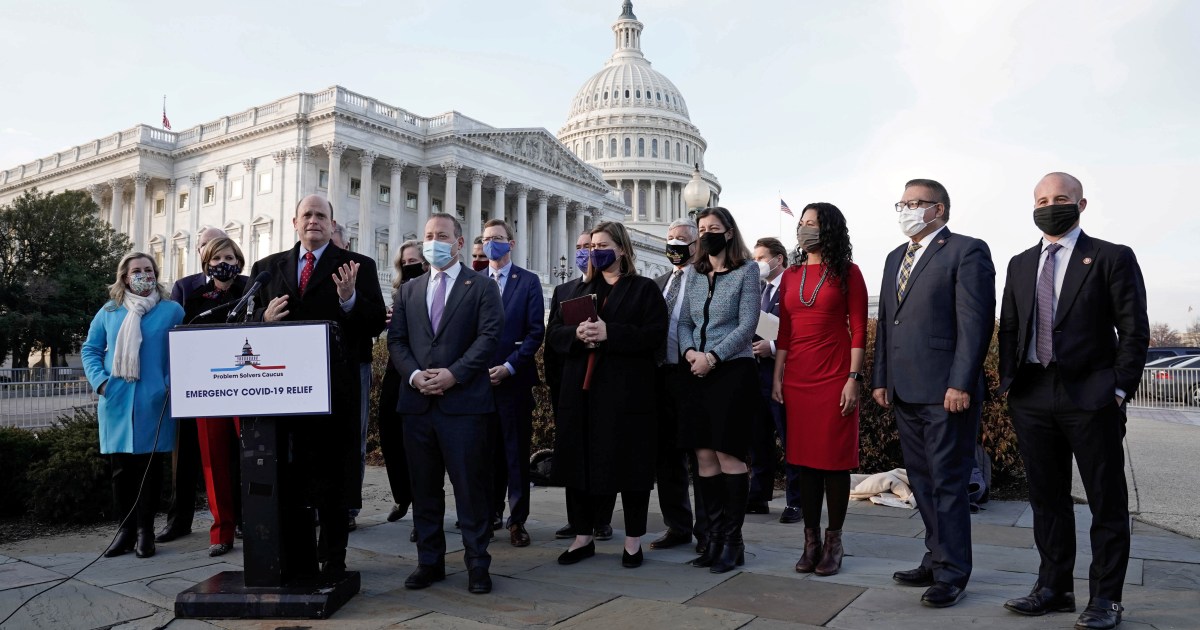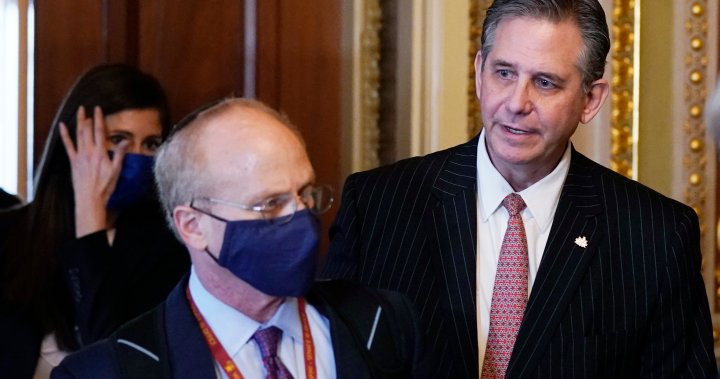What is the fight over the ‘COVID relief bill’ all about? | Coronavirus pandemic News
On December 21, the United States Senate finally passed a pandemic relief bill. The most attention-grabbing part of this legislation is the direct payments of $600 to almost every American.
A day later President Donald Trump got on TV and called it a “disgrace”.
“It’s called the COVID Relief Bill but it has almost nothing to do with COVID,” he declared, adding that Congress should “immediately get rid of the wasteful and unnecessary items from this legislation” and “increase the ridiculously low $600 to $2,000”.
It was a shock. He had never said anything remotely like that before.
So what happens next? Will he veto the bill, just as he vetoed the military spending bill on December 23?
As he so often does, Trump has latched on to a piece of reality then joyfully spun it into a huge misrepresentation. It is correct that the bill which passed on December 21 is constantly described as the COVID Relief Bill, but it is actually not.
It is actually part of an omnibus spending bill – a large package of smaller spending bills – called the House Amendment to the Senate Amendment to HR 133 and subtitled the Consolidated Appropriations Act, 2021.
It is 5,593 pages long and the COVID-19 relief legislation – worth about $900bn – is part of it. The other sheaves come to $1.4 trillion, for a total of $2.3 trillion. As a point of reference, the federal budget for 2020 was $4.79 trillion.
The bundle is not just bags of money. It covers some vital things, a mixed bag of government spending, as well as some very special favours for very special interests – a regular feature of almost every US government action.
The battle over the COVID relief part of the bill started in July, when the Democrats in the House of Representatives passed a pandemic stimulus package just as the previous one – voted in three months earlier – was about to expire. The bill then was passed on to the Republican-controlled Senate, where the GOP demanded things the Democrats would not accept – like protection from lawsuits for companies that did not properly protect their employees from the coronavirus – and offered little that they would accept.
The back-and-forth on the bill continued as the second wave of COVID-19 infections hit. In early December, a group of moderate Republicans and Democrats in the House, plus a few in the Senate came up with “a compromise package”. There was a lot of genuine give on both sides.
It was, in many ways, a return to normalcy. The bill was so huge and went through so fast that it was clear that the members of Congress who voted for it – and the few who voted against it – had not actually read it. That is actually far more normal than not.
The bill is written in such a way that unless you are very familiar with the history of each particular item, you would not know if it is going up, down, or sideways. Which is also normal.
It is a bulging Santa’s bag of special treats: it creates medication and safety standards for horse racing, makes illegal streaming of music and films a felony, provides for sanctions against any Chinese official who interferes with the selection of the next Dalai Lama, authorises the creation of a National Museum of the American Latino and a Smithsonian American Women’s History Museum, allocates $1.375bn for Trump’s wall on the US-Mexican border, foreign aid for Cambodia, Nepal, Burma, Ukraine, Pakistan, Egypt, and Sudan, some money for Israel and Jordan, and funding for one new submarine (even just one is expensive), eight submarine-hunting aircraft, sexual abstinence programmes, and Space Force. Packing such things into big, must-pass legislation is very normal.
The bill also includes the necessary authorisation of government spending which needs to be passed in order for the government to continue working. If the legislation does not pass, this threatens another government shutdown.
The COVID relief portion of the bill extends unemployment insurance benefits for an extra 11 weeks and adds $300 a week to those benefits. It also extends payroll protection (forgivable loans to businesses for keeping people on the job), eviction bans and provides some assistance for renters, childcare, education, food stamps, and, of course, the $600 for most adults and for their dependent children, which Trump calls a disgrace.
Democrats tried an instant pudding response, unanimous consent to an amendment to raise the $600 to the $2,000 that Trump had called for. It was the amount that the Democrats had wanted to begin with. They had gone for the lower figure only in order to get it through the Republican Senate.
“Unanimous consent” is an aptly named legislative manoeuvre. Just one naysayer can block it. The Republicans blocked it, going against Trump. House Speaker Nancy Pelosi immediately announced that the amendment to the bill will be presented for normal voting – which can pass it by a simple majority – this coming week.
That will be double jeopardy for Republicans. Voting against it will mean refusing to give more relief money to the American people – a Republican norm – but it will cost nearly every American $1,400. Worse, it means openly disagreeing with Trump at a time when falling in line with him has overridden any other possible value a Republican might have.
It is very hard to say how likely it is that such an amendment will pass. If it does, will Trump then gleefully announce “winning!” and sign it? Or will he move the goalpost?
Remember, he said there are many things in the bill that had nothing to do with COVID relief. Of course there are, because it is an omnibus spending bill. Most of the items he specified had been included in his own budget proposal. Would he be mollified if they were eliminated? Or roll out another list deemed “wasteful and unnecessary”?
Trump could veto the bill, but that can be overridden by a two-thirds vote in both the Senate and the House. Senate Majority Leader Mitch McConnell, with the agreement of Minority Leader Chuck Schumer, has already announced a plan to bring back the Senate on December 29 for a vote to override a possible presidential veto. Since it originally passed 359-53 in the House and 92-6 in the Senate, that should be easy.
Trump could also simply do nothing. That creates a “pocket veto”. If he does nothing for 10 days, not counting Sundays, the bill becomes law, provided that Congress is still in session. The problem is that this 10-day period ends in early January and the mandate of the old Congress ends January 3. Anything not passed into law by then simply disappears.
However, according to the 20th Amendment of the constitution, Congress can specify a different day for its adjournment. It could keep itself going until January 4 or 5 or later. And the bill would become law.
The other problem is that if the bill is not signed before December 28, the government will run out of money and shut down.
What should we expect?
Trump loves to destroy what others have accomplished. To imagine he has any other goal is to engage in self-delusion.
For now, Trump has gone off to Florida for yet another vacation, presumably, at least through January 1, 2021. He will be golfing, all expenses paid by the state to his own facilities.
Melania was kind enough to let Donald hold her hand for that photo op walking happily to Air Force One as they took off for Mar-a-Lago.
The views expressed in this article are the author’s own and do not necessarily reflect Al Jazeera’s editorial stance.





